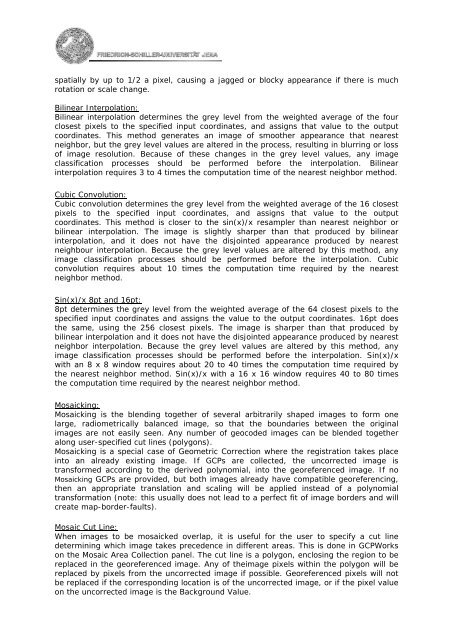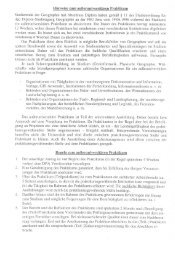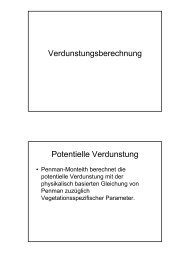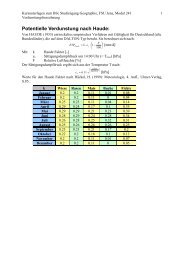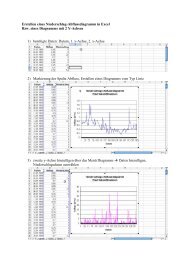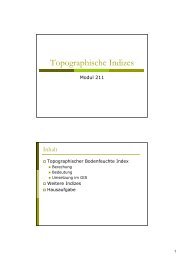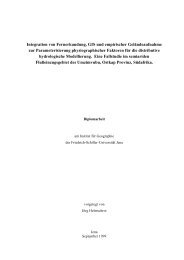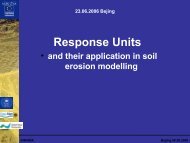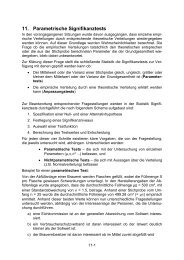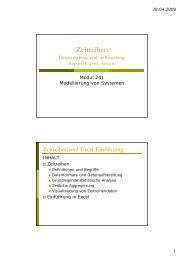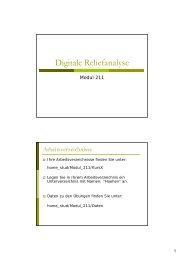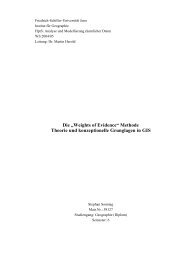Fernerkundung I (Digitale Bildverarbeitung) - Friedrich-Schiller ...
Fernerkundung I (Digitale Bildverarbeitung) - Friedrich-Schiller ...
Fernerkundung I (Digitale Bildverarbeitung) - Friedrich-Schiller ...
Create successful ePaper yourself
Turn your PDF publications into a flip-book with our unique Google optimized e-Paper software.
spatially by up to 1/2 a pixel, causing a jagged or blocky appearance if there is much<br />
rotation or scale change.<br />
Bilinear Interpolation:<br />
Bilinear interpolation determines the grey level from the weighted average of the four<br />
closest pixels to the specified input coordinates, and assigns that value to the output<br />
coordinates. This method generates an image of smoother appearance that nearest<br />
neighbor, but the grey level values are altered in the process, resulting in blurring or loss<br />
of image resolution. Because of these changes in the grey level values, any image<br />
classification processes should be performed before the interpolation. Bilinear<br />
interpolation requires 3 to 4 times the computation time of the nearest neighbor method.<br />
Cubic Convolution:<br />
Cubic convolution determines the grey level from the weighted average of the 16 closest<br />
pixels to the specified input coordinates, and assigns that value to the output<br />
coordinates. This method is closer to the sin(x)/x resampler than nearest neighbor or<br />
bilinear interpolation. The image is slightly sharper than that produced by bilinear<br />
interpolation, and it does not have the disjointed appearance produced by nearest<br />
neighbour interpolation. Because the grey level values are altered by this method, any<br />
image classification processes should be performed before the interpolation. Cubic<br />
convolution requires about 10 times the computation time required by the nearest<br />
neighbor method.<br />
Sin(x)/x 8pt and 16pt:<br />
8pt determines the grey level from the weighted average of the 64 closest pixels to the<br />
specified input coordinates and assigns the value to the output coordinates. 16pt does<br />
the same, using the 256 closest pixels. The image is sharper than that produced by<br />
bilinear interpolation and it does not have the disjointed appearance produced by nearest<br />
neighbor interpolation. Because the grey level values are altered by this method, any<br />
image classification processes should be performed before the interpolation. Sin(x)/x<br />
with an 8 x 8 window requires about 20 to 40 times the computation time required by<br />
the nearest neighbor method. Sin(x)/x with a 16 x 16 window requires 40 to 80 times<br />
the computation time required by the nearest neighbor method.<br />
Mosaicking:<br />
Mosaicking is the blending together of several arbitrarily shaped images to form one<br />
large, radiometrically balanced image, so that the boundaries between the original<br />
images are not easily seen. Any number of geocoded images can be blended together<br />
along user-specified cut lines (polygons).<br />
Mosaicking is a special case of Geometric Correction where the registration takes place<br />
into an already existing image. If GCPs are collected, the uncorrected image is<br />
transformed according to the derived polynomial, into the georeferenced image. If no<br />
Mosaicking GCPs are provided, but both images already have compatible georeferencing,<br />
then an appropriate translation and scaling will be applied instead of a polynomial<br />
transformation (note: this usually does not lead to a perfect fit of image borders and will<br />
create map-border-faults).<br />
Mosaic Cut Line:<br />
When images to be mosaicked overlap, it is useful for the user to specify a cut line<br />
determining which image takes precedence in different areas. This is done in GCPWorks<br />
on the Mosaic Area Collection panel. The cut line is a polygon, enclosing the region to be<br />
replaced in the georeferenced image. Any of theimage pixels within the polygon will be<br />
replaced by pixels from the uncorrected image if possible. Georeferenced pixels will not<br />
be replaced if the corresponding location is of the uncorrected image, or if the pixel value<br />
on the uncorrected image is the Background Value.


